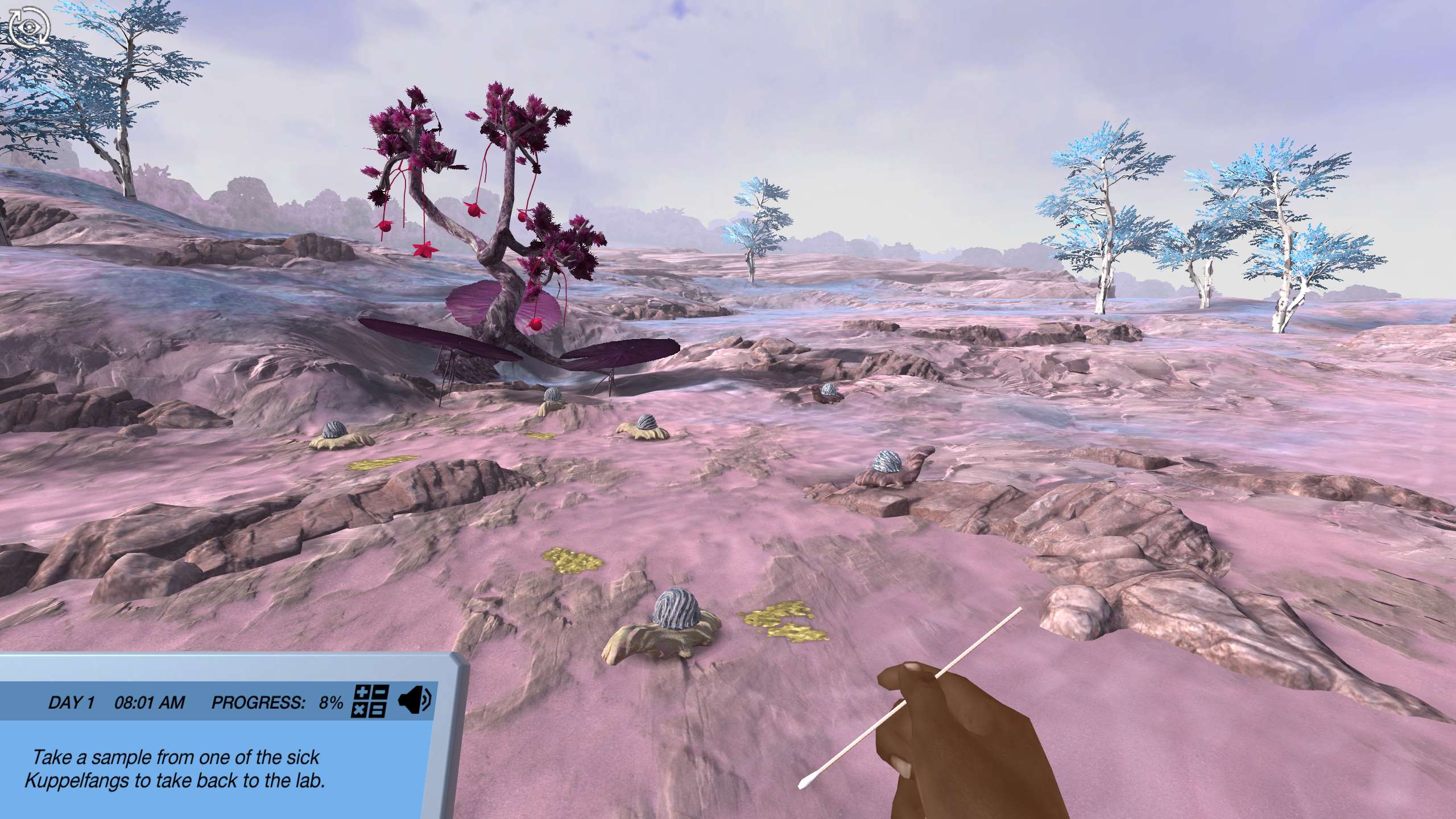Heading 1
Heading 2
Heading 3
Heading 4
Heading 5
Heading 6
Lorem ipsum dolor sit amet, consectetur adipiscing elit, sed do eiusmod tempor incididunt ut labore et dolore magna aliqua. Ut enim ad minim veniam, quis nostrud exercitation ullamco laboris nisi ut aliquip ex ea commodo consequat. Duis aute irure dolor in reprehenderit in voluptate velit esse cillum dolore eu fugiat nulla pariatur.
Block quote
Ordered list
- Item 1
- Item 2
- Item 3
Unordered list
- Item A
- Item B
- Item C
Bold text
Emphasis
Superscript
Subscript
About This Simulation
Visit the exoplanet Astakos IV, where the Kuppelfang population is suffering from a bacterial infection. Use staining, differential media and biochemical tests to identify the bacteria so that the Kuppelfangs can be treated before they go extinct.
Learning Objectives
- Explain the importance of correctly identifying pathogenic bacteria
- Outline the principle of the main bacterial identification methods
- Describe the use and limitations of bacterial morphology and differential staining techniques
- Critically combine biochemical tests such as the catalase, oxidase and indole test with differential staining and differential media to identify pathogenic bacteria
About This Simulation
Lab Techniques
- Biochemical tests (catalase test and oxidase test strip)
- Differential culture media
- Bacterial staining interpretation
- Aseptic Technique
Related Standards
- No direct alignment
- No direct alignment
- No direct alignment
Learn More About This Simulation
Extraterrestrial life has been found! Sadly, some of the creatures have been infected with a bacterium from Earth. In this simulation, you will learn to identify unknown bacteria. Just like in clinical settings on Earth, it is important to identify unknown pathogens for diagnosis and treatment. Explore clinical microbiology techniques, such as differential staining, differential and selective media and biochemical assays, then use your new skills to identify the bacteria.
Explore clinical microbiology techniques
Explore the lab and get to know different clinical microbiology techniques and how they work by playing a mini-game. You will have to figure out how to use all the tools and reagents and guess which results you can expect from each assay. Depending on your level of knowledge, you can spend more or less time exploring the lab and engaging with the explanatory conversations.
Critically combine tests to identify unknown bacteria
Interpret a Gram stain, then culture your sample using differential media and perform the catalase, oxidase and indole biochemical tests on it. Critically combine the results of these assays in order to identify the unknown bacterium. Because different bacteria can cause similar symptoms, the lab assistant Dr. One has taken a sample of another infected Kuppelfang. Help out by interpreting Dr. One’s results or re-do the simulation and choose another Kuppelfang to take a sample of if you want more practice with any of the techniques.
Administer treatment and verify your results
Communicate your results and see whether your Kuppelfang patients improve after treatment. Meanwhile, your colleague on Earth has analyzed your sample with a nucleic acid-hybridization assay. Do their results match your own?
For Science Programs Providing a Learning Advantage
Boost STEM Pass Rates
Boost Learning with Fun
75% of students show high engagement and improved grades with Labster
Discover Simulations That Match Your Syllabus
Easily bolster your learning objectives with relevant, interactive content
Place Students in the Shoes of Real Scientists
Practice a lab procedure or visualize theory through narrative-driven scenarios


FAQs
Find answers to frequently asked questions.
Heading 1
Heading 2
Heading 3
Heading 4
Heading 5
Heading 6
Lorem ipsum dolor sit amet, consectetur adipiscing elit, sed do eiusmod tempor incididunt ut labore et dolore magna aliqua. Ut enim ad minim veniam, quis nostrud exercitation ullamco laboris nisi ut aliquip ex ea commodo consequat. Duis aute irure dolor in reprehenderit in voluptate velit esse cillum dolore eu fugiat nulla pariatur.
Block quote
Ordered list
- Item 1
- Item 2
- Item 3
Unordered list
- Item A
- Item B
- Item C
Bold text
Emphasis
Superscript
Subscript
A Labster virtual lab is an interactive, multimedia assignment that students access right from their computers. Many Labster virtual labs prepare students for success in college by introducing foundational knowledge using multimedia visualizations that make it easier to understand complex concepts. Other Labster virtual labs prepare learners for careers in STEM labs by giving them realistic practice on lab techniques and procedures.
Labster’s virtual lab simulations are created by scientists and designed to maximize engagement and interactivity. Unlike watching a video or reading a textbook, Labster virtual labs are interactive. To make progress, students must think critically and solve a real-world problem. We believe that learning by doing makes STEM stick.
Yes, Labster is compatible with all major LMS (Learning Management Systems) including Blackboard, Canvas, D2L, Moodle, and many others. Students can access Labster like any other assignment. If your institution does not choose an LMS integration, students will log into Labster’s Course Manager once they have an account created. Your institution will decide which is the best access method.
Labster is available for purchase by instructors, faculty, and administrators at education institutions. Purchasing our starter package, Labster Explorer, can be done using a credit card if you are located in the USA, Canada, or Mexico. If you are outside of North America or are choosing a higher plan, please speak with a Labster sales representative. Compare plans.
Labster supports a wide range of STEM courses at the high school, college, and university level across fields in biology, chemistry, physics, and health sciences. You can identify topics for your courses by searching our Content Catalog.















